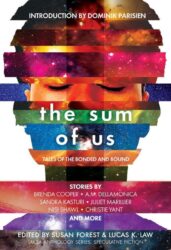A Spectacle of Beauty and Estrangement
A Spectacle of Beauty and EstrangementA review of Marie Bilodeau’s Nigh Book 3 (S &G Publishing, 2015)
The third book of Nigh by Marie Bilodeau brings the reader into the realm of fairy itself, a land hostile to human life but simultaneously an object of desire. Bilodeau’s fairy realm is a land that is changeable between one moment to the next from a space of growth to a landscape of decay. It is a realm of uncertainty and this poses a problem for Al, a mechanic who always wants to know how things work and wants to take things apart and figure out the mechanisms for them to run. The fairy realm resists the very notion of being understood. It resists logic and the more Al probes into the world, the more she is met with confusion and disorientation.
Bilodeau, always an author who plays with the complexity and power of stories to shape human lives, explains the history of telling fairy tales as a way for human beings to prepare later generations for the experience of entering into the fairy realm. She plays with the notion of speculation as a way of understanding another reality and suggests that story-telling has historically been a survival mechanism for human contact with other realms. In this way, Marie Bilodeau invites us to question the way story-telling tells us about our own world, about ourselves, and about the way we understand our relationship to the world. Nigh Book 3 plays with the landscape in a unique way, experimenting with a question that Northrop Frye suggests much of Canadian literature deals with: “Where is here?” The fairy realm represents a space entirely defined by uncertainty. The uncertainty of the fairy landscape is not divorced from human responsibility. We are partially responsible for that shifted, changed, hostile landscape where the fairies have dwelled. We are told by the fairies that human actions have fragmented the fairy world and that damage and changes to our environment have meant that the fairy worlds (parallel to our own) have been torn apart, families ripped asunder. The altering of our world has similarly altered and changed the realm that has become harmful to us.
In this third book of Nigh, Bilodeau gives context to the fairies, greying their morality instead of presenting them as entirely ‘evil’. The fairypocalypse is made more complex by adding the complexities of fairy voices to the experience, giving them the opportunity to explain their position and challenge that view of them as entirely other to human experienc eand hostile to human existence.
The human presence in the fairy landscape is marked by loss, by a change so hostile to humanity that the human beings themselves begin to slip away, losing elements of their identity. While in the fairy world, characters experience the infiltration into their bodies of difference, strangeness, and, in some cases, the loss of memory and selfhood. Bilodeau’s characters are need to question their identity, their memories, and the things that make them who they are as they submerge into a strange, foriegn, and hostile land. In Nigh book 3 Marie Bilodeau examines our complex relationship to our landscapes and the way that our environment changes and alters us.
To find out more about Marie Bilodeau’s work, visit her website at http://mariebilodeau.blogspot.com


